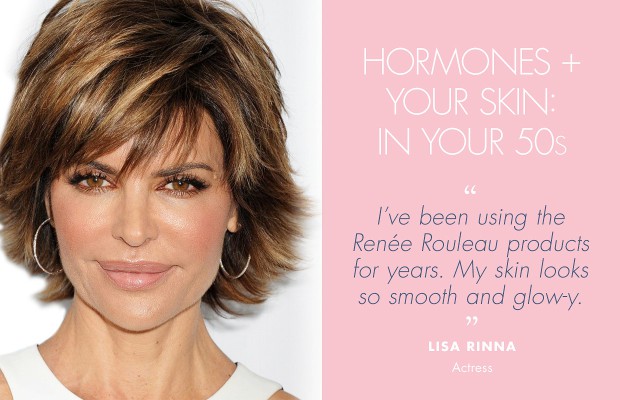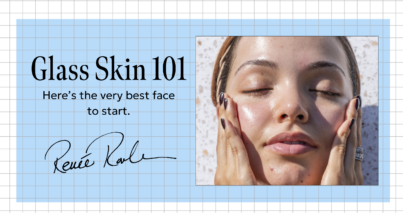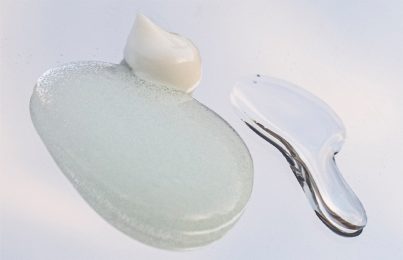Updated 3/20/19. Intrinsic aging is determined by heredity, your genetic programming on a cellular level that controls the hormones responsible for aging. The skin will behave differently under the influences of these hormones, but how will you be affected from ages 50-60?
- How is the skin affected by hormones during the ages of 50-60?
- Expert tips for getting your skin to look more radiant, firm and smoother in your 50s
- Use soothing ingredients in your skin care products if your skin acts sensitive
- Increase blood flow and circulation within the skin
- Wear sunscreen every single day—even when indoors or on cloudy days
- Look for ways to manage facial hair and peach fuzz
- Repair your skin’s moisture barrier
- Get professional skin care treatments
- Eat almonds, salmon, avocados and olive oil
- Keep up your exercise
- Load up (inside and out) with antioxidant-rich foods and skincare products
- Ease up on prescription retinoids
- Drink alcohol in moderation
- Get an annual skin cancer screening by a dermatologist
- Use firming ingredients in your skin care products
- Don’t neglect your neck
- Be sure to exfoliate the skin often
- Get plenty of sleep so your skin can repair properly
- For a deeper dive into your hormone-related concerns, consult with an endocrinologist
Usually occurring sometime after the age of 50, hormone changes cause the cessation of monthly periods which results in menopause. These are the years when estrogen is declining rapidly and because of this, you’ll experience changes in the skin’s texture as well as loss of tone and increased facial hair. In this post, I’ll go into detail about the hormonal shifts taking place in your 50s and share my expert tips for things you can start doing now to counteract the visible effects.
How is the skin affected by hormones during the ages of 50-60?
- Progesterone (regulates sleep, immunity and brain function)
- Estrogen (supports collagen production which is responsible for keeping the skin plump and free of wrinkles)
- Testosterone (regulates oil glands and hair growth)
- DHEA (protects against oxidative stress which is an important function in preventative skin aging)
- Human growth hormone (supports skin’s elasticity and muscle)
The decrease or change in these hormones is a main factor in the intrinsic aging process and will all play a part in the visible aging of the skin.
Estrogen, which drops quickly, can create hot flashes and the propensity for skin reactions such as rosacea. Overactive mast cells perceive non-threatening stimuli as dangerous and cause sensitivity and allergic reactions. Besides the discomfort of skin irritations, it is now believed that inflammation is the major cause of aging. The inflammation cascade of chemical changes that occurs in the skin can cause irreparable damage to skin cells.
Estrogen is very involved in the normal function of the skin. It directly affects the function of key cells in the skin, like the fibroblasts (produces collagen and elastin), keratinocytes (closely involved in skin protection) and melanocytes (involved in evenness of skin color). It also helps regulate hair follicle function (hair production) as well as sebaceous gland activity (producing skin oils). Estrogen also grabs onto water and holds it in the dermis, keeping the skin plump. With the extreme decrease in estrogen that occurs in the 50s, the skin deflates due to the loss of the natural padding of fat beneath the skin. This causes wrinkles to become more pronounced. In addition, microcirculation may be less efficient and the skin will thin from lack of nutrients and oxygen.
Hormonal swings tied to aging also account for an increase in facial hair (peach fuzz), particularly on the cheeks, chin and upper lip. The menopausal years also trigger skin growths on the face and body like these. They begin as small, rough bumps and over time, they thicken and get larger. There are many names for these: seborrheic keratoses, actinic keratoses, skin tags, sebaceous hyperplasia, and they all can appear a bit different (some brown, some flesh color) but generally speaking, they are bumps, excess skin, enlarged oil glands and growths that protrude from the skin and become impossible to hide with makeup.
Simply put, the 50s are the decade when the most visible changes related to aging occur in the skin. (No fun!)
Expert tips for getting your skin to look more radiant, firm and smoother in your 50s
Use soothing ingredients in your skin care products if your skin acts sensitive
If you’re finding that your skin is more easily reactive, it’s important that you introduce products containing anti-inflammatory properties to your skin. Ingredients like sea whip extracts, white tea, licorice, meadowsweet, chamomile and azulene are all beneficial for calming redness in overactive skin types. Skin types #5 and #9 are both geared towards red, sensitive skin.
Increase blood flow and circulation within the skin
For skins that are not experiencing redness or rosacea but are looking tired, dull and sluggish, it’s important to address circulation. Skin cells, like all cells that make up the tissues and organs of the body, depend on good circulation to get the required oxygen, water, hormones, nutrients, minerals and other trace elements that are vital for the life of the cells. The tissues rely on the circulatory system to remove wastes and toxins. Tired, sluggish skin occurs when the microcapillaries are not providing enough nutrition to the skin. The treatment for under-circulated skin is to try to gently stimulate circulation through gentle massage (manual exfoliants/facial scrubs like Mint Buffing Beads) and using stimulating ingredients such as ginseng, peppermint, and rosemary. You’ll also want to encourage the mitochondria of the cell to harness its energy with ingredients like niacinamide found in Energy Boosting Toner.
Wear sunscreen every single day—even when indoors or on cloudy days
Research indicates that 78% of all sun damage incurred in a lifetime is from incidental exposure. It’s all those times when you don’t think you’re getting sun because you aren’t out there long enough to actually get a tan. Driving in the car and walking down the street on a cloudy day is still very damaging to your skin. Just because you don’t purposely seek out a tan doesn’t mean you’re not getting the sun’s harmful rays. On days that are spent indoors, you’re still getting the damaging rays coming through windows in the form of daylight. Wear a sunscreen built into your moisturizer, applied to both your face and neck, every day, 365 days a year, rain or shine, inside or out. It’s the easiest and most effective way to slow down how quickly your skin will visibly age. I recommend Weightless Protection SPF 30 for those in their 50s since it’s very lightweight and very compatible under makeup.
Look for ways to manage facial hair and peach fuzz
When the skin has a lot of light hairs, it’s not going to look as smooth or be as glow-y as you want it to be. Plus, liquid foundation makeup is harder to blend in when the skin is fuzzy. Waxing, shaving, dermaplaning or threading are all options to consider to keep visible hair less noticeable. These are all considered safe methods of hair removal and will NOT encourage increased hair growth.
Repair your skin’s moisture barrier
The skin has a moisture barrier made of natural lipids and when it is damaged (due to age, climate, and hormone changes), tiny, invisible cracks in the skin are created, allowing moisture to escape and irritants to enter more easily. This causes the skin to get dry, rough and flaky and easily inflamed. Inflammation causes a chain of biochemical reactions that lead to collagen and elastin breakdown. If the skin’s barrier function is intact and healthy, inflammation is much less likely to occur.
There are very specific emollient ingredients in certain moisturizers that can help repair the moisture barrier. Look for moisturizers or treatment oils containing like rose hip seed oil, borage oil, jojoba oil and sweet almond oil. Ingredients like shea butter, ceramides, squalane, and phospholipids will also soothe the skin and help repair a damaged moisture barrier. (See the full list of best moisture repairing ingredients here.) I recommend Pro Remedy Oil to dramatically repair dryness.
Read more about how to fix a damaged moisture barrier.
Get professional skin care treatments
Especially in the 50s when the signs of aging are settling in due to hormone changes, putting your skin in the hands of a professional is so important to give a boost of results. Skin care products at home will play their part but professional treatments like facials, micro-current, lasers and chemical peels all work to give a lot of improvement. Botox and dermal fillers are options, too but read this first.
 Eat almonds, salmon, avocados and olive oil
Eat almonds, salmon, avocados and olive oil
These all contain healthy fats that keep your skin moist, supple and glowing from inside out. They are much needed in your 50s, since moisture levels will drop significantly within the skin.
Keep up your exercise
The 50s may find you slowing down with your workout routine but this is not recommended. Moderate exercise is an important part of skin care. Exercise keeps your muscles strong and firm which in places such as your arms, will support the skin and give it a smoother look. Exercise is beneficial for increasing blood flow and carrying oxygen and nutrients to the skin as well as stimulating neurons which are good for brain health.
Load up (inside and out) with antioxidant-rich foods and skincare products
It is widely recognized by almost every doctor, skin researcher and health professional on the planet that the key to aging in a healthier way is to protect your cells with antioxidants. This is known as the free radical theory of aging. This theory states that the main reason why we age is that unstable electrons in molecules known as free radicals attack healthy cells and change their composition. These free radicals are very potent toxins that ultimately damage the skin. First, they attach to proteins and other essential molecules, making the molecules unable to function normally, as healthy, younger cells do. This ultimately results in the premature death of the attacked cells. Sounds tragic, I know.
Free radicals can come from UVA and UVB rays from the sun, pollution, stress smoking, alcohol, fatty foods and even aerobic repetitive exercise. When exposed to these, the parts of the cell susceptible to damage are DNA, lipids, and proteins. This, then, slows down the production of collagen and elastin, which is essential in keeping the skin firm and preventing wrinkling. This entire process happens beneath our skin every minute of every day, making wrinkles, brown spots and sagging more visible over time.
The good news is that antioxidants found in products (such as stabilized vitamins A, C and E like in Vitamin C&E Treatment and Firm + Repair Overnight Serum) are incredibly effective at slowing the process of visible aging. They’re so effective because antioxidants essentially prevent free radicals from oxidizing molecules.
In addition to specially formulated products, eating vegetables and fruits will give your body antioxidants internally. When consumed frequently, they’re a natural, inexpensive way to slow the signs of aging from inside out. The best ones are avocados, berries, sweet potatoes, broccoli, spinach, tomatoes, and carrots. A diet rich in color is going to benefit both your skin and body.
Ease up on prescription retinoids
As much as I’m an advocate of prescription retinoids for their incredible ability to dramatically smooth the skin’s texture, it’s important to know that they can make the skin a bit thinner. Since the skin is already naturally thinning out in your 50s, it might cause it to act more sensitive and make capillaries show through the skin more easily. If you’ve been a regular user of prescription retinoids, you might consider switching to a product using retinol (available without a prescription) which works less aggressively in its smoothing ability. Read more about retinol and prescription retinoids.
Drink alcohol in moderation
Regular, habitual, excessive drinking will visibly age your skin faster. Overconsumption of alcohol causes chronic inflammation and harmful free radical activity, as mentioned above. This gradually wears on connective tissues, resulting in flaccid, loose, sagging skin. Moderation is key.
Get an annual skin cancer screening by a dermatologist
Did you know that melanoma is the fastest growing and most deadly type of cancer and that one out of five Americans will eventually develop skin cancer? It’s thought that 40-50% of Americans will develop skin cancer by the age of 65 so it’s really important that you get your skin checked by a dermatologist. In Caucasians, most skin cancers present initially on the skin itself, usually in areas of sun exposure such as the face, scalp, back, nose, and arms. In Asian, African, or Hispanic people with darker complexions, melanomas often present in non-sun exposed – or less pigmented – areas such as the palms of the hand or on the nail beds.
Use firming ingredients in your skin care products
An effective way to encourage the stimulation of collagen and elastin is by using products containing peptides. Peptides are protein fragments that can stimulate the production of dermal proteins (collagen and elastin) and can thicken the dermis (the mattress under the skin that keeps the skin plump) without any harsh side effects. I recommend Firm + Repair Overnight Serum which contains Palmitoyl Tripeptide-38, one of the best peptides for supplying skin-rebuilding essentials necessary for improving facial contours.
Don’t neglect your neck
This area is often overlooked and will start to show the effects of aging and sun damage in your 50s. Applying sunscreen generously to the front and sides of the neck is one of the best ways to prevent premature aging, so be sure to get into this habit daily when performing your morning routine. Here are more of my expert tips to repair the look of sun damage on the neck and chest.
Be sure to exfoliate the skin often
By removing surface, dry skin cells, you reveal healthy and vibrant skin. When caring for your skin, the phrase “out with the old, in with the new” really holds true. Exfoliation removes expired, dry skin cells making way for new, healthy, plump skin cells. In the removal process, it will also rid the skin of unwanted brown spots to create a smoother, more even-toned complexion. A weekly, at-home skin peel is great when used in the 50s to dramatically resurface the skin’s texture. I recommend Triple Berry Smoothing Peel. Read my beginner’s guide to using exfoliants.
Get plenty of sleep so your skin can repair properly
From a stress management standpoint as well as a way to keep your skin in good shape, quality sleep is essential. Did you know that collagen production is accelerated during sleep? If you are consistently sleep deprived, not enough collagen is produced to replace what inflammation will naturally break down. During the deepest stage of rest, growth hormones peak and stimulate cell and tissue repair. Beauty sleep is essential in your 50s.
For a deeper dive into your hormone-related concerns, consult with an endocrinologist
This is a special kind of physician who specializes in hormonal issues. Aside from changes in your skin, it’s normal in your 50s to have other disruptions. An endocrinologist can run all sorts of tests to provide specialized help for those who have constant hormone fluctuations.
Read how hormones affect the skin in your teens, 20s, 30s, 40s and 60s.
Want to learn more? Here are 34 helpful tips.
Celebrity Esthetician & Skincare Expert
As an esthetician trained in cosmetic chemistry, Renée Rouleau has spent 35 years researching skin, educating her audience, and building an award-winning line of products. Her hands-on experience as an esthetician and trusted skin care expert has created a real-world solution — products that are formulated for nine different types of skin so your face will get exactly what it needs to look and feel its best. Trusted by celebrities, editors, bloggers, and skincare obsessives around the globe, her vast real-world knowledge and constant research are why Marie Claire calls her “the most passionate skin practitioner we know.”






Comments:
I need advice on what kind of vitamin c serum I should use for sensitive, oily (clogged pores), 48yr old skin. I need help with collagen, large pores, skin texture, pigmentation, etc. Please help!!!!
Posted By: michelle |
Hi Michelle, Read this post about my favorite vitamin c serum and why it works so well.
Posted By: Renée Rouleau |